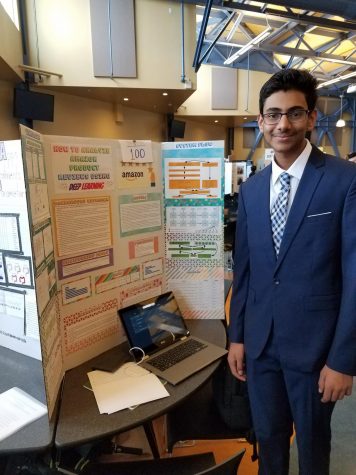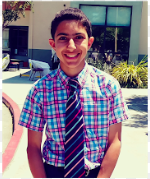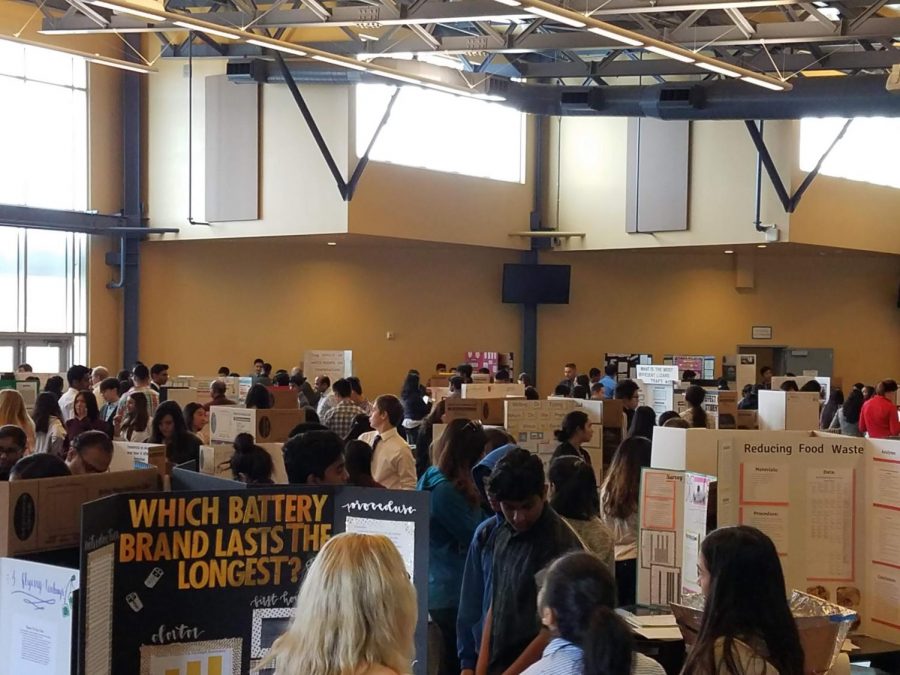2nd Annual DHS Science and Engineering Fair Brings New Champions
2nd Annual DHS Science and Engineering Fair included over 250 different projects displayed in two different sessions.
On Saturday, February 9th, Dublin High School hosted its second annual science and engineering fair. After five months of hard work, DHS students stood next to their projects for an hour and a half, either in the morning or afternoon, and presented to a number of judges. From literature reviews on piezoelectricity to engineering projects on backpack design, a multitude of different projects could be found at this year’s fair.
A record number of approximately 425 freshmen represented over 250 different projects. Over fifty freshman projects placed in the top 20% in their respective categories and received a 3% semester grade bump for their Biology with Research class. Of the 250 freshman projects, eight were given the chance to move on to the Golden Gate STEM Fair (GGSF) in March, competing against Bay Area students from nine different counties. From there, they could potentially move on to the California Science and Engineering Fair or the International Science and Engineering Fair (ISEF). A total of twelve projects were selected for GGSF: four upperclassmen projects who did not present at the school fair but were recognized for their phenomenal research outside of school, in addition to the eight freshman projects who won the fair.
Tanish Barnwal, one of the eight freshmen selected to move on to GGSF, built a classifier using deep learning strategies that take Amazon reviews and groups them based on their rating (one to five stars). Tanish commented on the differences between the DHS science fair and GGSF, explaining how “you don’t get interviewed privately, so it’s all on your board. There’s a lot of stuff that you have to literally type on the board.” However, he still believes he can make it to ISEF, “but it will take of a lot of redesigning [of his board].”

The DHS Science and Engineering Fair originated from the creation of a special class for freshman, Biology with Research. Seven years ago, when talk of a school science fair was first starting, the district office was hoping to get more DHS students to participate in county science fairs. Ms. Kaehms, who happened to be the co-chair of the science department at the time, suggested that they “create a group of students that participate in the science fair as part of their class.” The department was also hoping to create some kind of advanced Biology course. Thus, Biology with Research was born. Initially, students would just complete a science project as part of the class and did not have to present at a school-wide science fair, until the official DHS science fair was established just last year. Lawrence Livermore National Laboratories and Sandia National Laboratories both sponsored the introduction of the science fair at DHS, while also aiding Ms. Kaehms with grants as she developed the Biotechnology course that is now offered to seniors at DHS.
Since then, both the class and the science fair have been a great success. In prior years, two freshman science projects have made it all the way to the International Science and Engineering Fair (ISEF). Ms. Kaehms commented on the success of students in the DHS Science Fair, noting that “students have published the work they did as a freshman in real scientific journals. It’s really amazing the stuff that they’ve done. I have another student who’s hoping to publish what she did over the summer as a sophomore.” She went on to add that “[the DHS science fair] has changed the paradigm here about what research is because once you do it, you’re like ‘Oh, that wasn’t so hard.’ I mean it’s a little tedious, and there’s a lot of details to figure out, but you can do it. And so more people do research right now.”
The science fair has greatly encouraged DHS students to engage in scientific research of their own, and the results have been phenomenal. Now it is time for the next round of motivated DHS students to present their research to the world, and get their names on the ISEF list just as students in the past have.
Your donation will support the student journalists of Dublin High School. Your contribution will allow us to purchase equipment and cover our annual website hosting costs.

Sahand Adibnia is a freshman at Dublin High School and first-time writer for the Dublin Shield. His passion for journalism and editorials covering a wide...



































